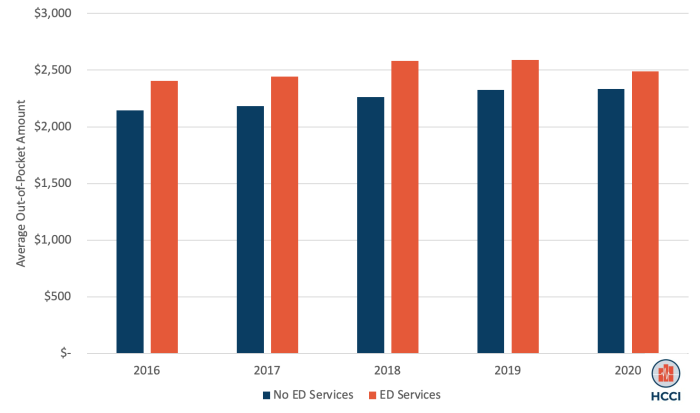All HCCI Reports
Growing Rate of Billed Emergency Department Use in Childbirth Inpatient Admissions
A recent KHN article reported on the growing presence of "obstetric emergency departments" (OBEDs) in U.S. hospitals. Hospitals suggest that OBEDs, which are generally located within labor and delivery departments and often indistinguishable from standard triage rooms, allow pregnant patients with potential emergent conditions (or when they are in labor) to be seen quickly by hospitalists. Patients are often unaware that they are receiving "emergency department" care in this setting until they receive the bill for their childbirth hospital admission and find it contains claims for emergency services. The article reports that private equity companies have been involved in the establishment and operations of OBEDs as a strategy to increase profits, leading to patients facing high bills for these services.
In this brief, we use the Health Care Cost Institute's unique commercial claims dataset to provide national data on how frequent OBED services are and how much they cost birthing people. Containing claims for 55 million people with health insurance through their employer, HCCI's data allows us to examine the prevalence of billed emergency department use during childbirth inpatient admissions between 2012 and 2020.
The Rate of Emergency Department Services During Childbirth Admissions Grew 138% Between 2012 and 2020
In 2020, 10% of the more than 400,000 inpatient admissions for births in our data had an emergency department (ED) service billed during the admission. Although most childbirth inpatient admissions do not include ED use, the proportion that do has grown substantially over time. In 2012, 45 out of 1,000 childbirth admissions included a claim for an ED service; by 2020, this rate had grown to 107, a 138% increase (Figure 1).
The growth in the rate of ED services during childbirth admissions between 2012 and 2020 was similar for vaginal (141%) and c-section deliveries (130%). In absolute terms, the rate was higher for vaginal deliveries in all years (Figure 1). Together, these findings suggest that the increase in ED services during childbirth admissions was not driven by a growing share of complex childbirth cases, since these cases more often result in c-sections.
Figure 1. The Rate of ED Services during a Childbirth Admission rose close to 140% between 2012 and 2020
Birthing People with an Emergency Service During their Childbirth Admission Paid $250 More Out-of-Pocket, on Average, than Those Without
Pooling 2016-2020, birthing people with an ED service during their admission for childbirth paid over $250 more, on average, out-of-pocket compared to patients without ED services during childbirth. In 2020, for example, birthing people with an ED service paid nearly $2,500 on average out-of-pocket compared to approximately $2,300 among birthing people without an ED service (Figure 2).
Figure 2: Out-of-Pocket Payment for Childbirth Admissions with ED Services Was on Average $250 Higher than for Childbirth Admissions without ED Services
If these ED services are not clinically appropriate, then they are unnecessarily increasing the spending burden on birthing people, who already spend over $2,000 on average to deliver their baby. Although most childbirth admissions do not include an ED service, the share that does has grown 140% since 2012. It is important to understand whether these services improve health outcomes for birthing people and babies, or whether these increased costs are largely due to the growing presence of private equity in obstetric care, which raises concerns for policymakers, payers, and patients.
When you subscribe to the blog, we will send you an e-mail when there are new updates on the site so you wouldn't miss them.


